BMW Z3 2002 Owner's Manual
Manufacturer: BMW, Model Year: 2002, Model line: Z3, Model: BMW Z3 2002Pages: 187, PDF Size: 2.73 MB
Page 21 of 187
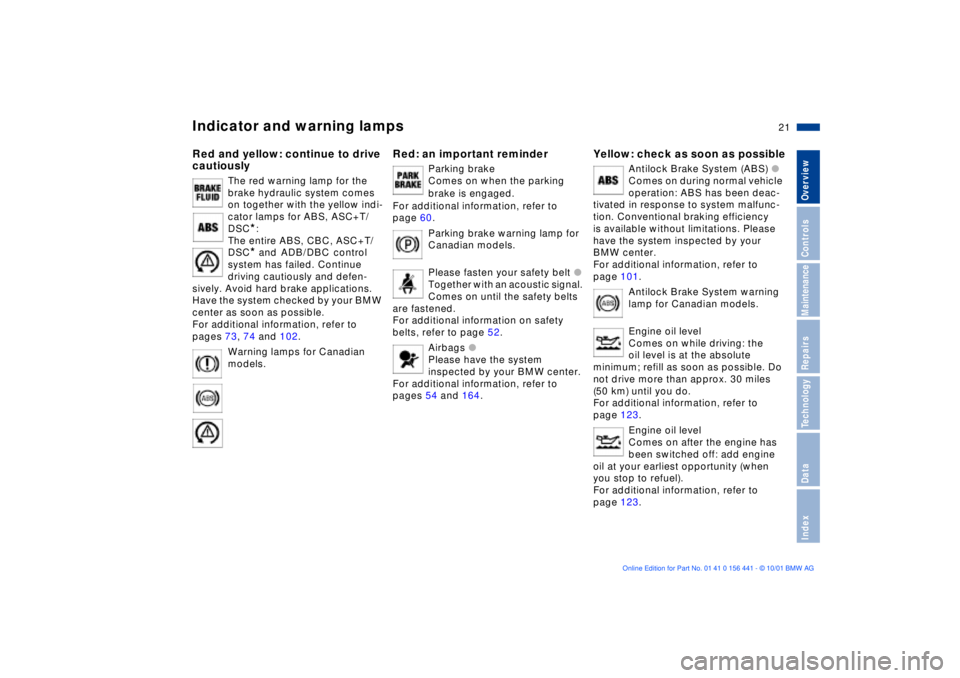
21n
IndexDataTechnologyRepairsMaintenanceControlsOverview
Indicator and warning lamps
Red and yellow: continue to drive
cautiously
The red warning lamp for the
brake hydraulic system comes
on together with the yellow indi-
cator lamps for ABS, ASC+T/
DSC
*
:
The entire ABS, CBC, ASC+T/
DSC
*
and
ADB/DBC
control
system has failed. Continue
driving cautiously and defen-
sively. Avoid hard brake applications.
Have the system checked by your BMW
center as soon as possible.
For additional information, refer to
pages 73, 74 and 102.
Warning lamps for Canadian
models.
Red: an important reminder
Parking brake
Comes on when the parking
brake is engaged.
For additional information, refer to
page 60.
Parking brake warning lamp for
Canadian models.
Please fasten your safety belt
l
Together with an acoustic signal.
Comes on until the safety belts
are fastened.
For additional information on safety
belts, refer to page 52.
Airbags
l
Please have the system
inspected by your BMW center.
For additional information, refer to
pages 54 and 164.
Yellow: check as soon as possible
Antilock Brake System (ABS)
l
Comes on during normal vehicle
operation: ABS has been deac-
tivated in response to system malfunc-
tion. Conventional braking efficiency
is available without limitations. Please
have the system inspected by your
BMW center.
For additional information, refer to
page 101.
Antilock Brake System warning
lamp for Canadian models.
Engine oil level
Comes on while driving: the
oil level is at the absolute
minimum; refill as soon as possible. Do
not drive more than approx. 30 miles
(50 km) until you do.
For additional information, refer to
page 123.
Engine oil level
Comes on after the engine has
been switched off: add engine
oil at your earliest opportunity (when
you stop to refuel).
For additional information, refer to
page 123.
Page 22 of 187
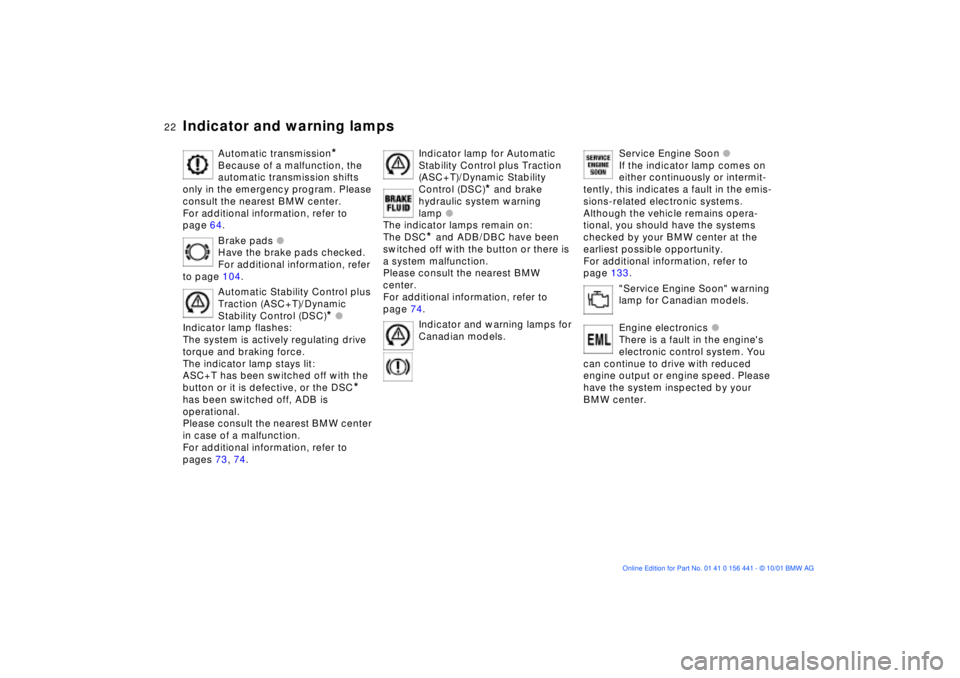
22n
Indicator and warning lamps
Automatic transmission
*
Because of a malfunction, the
automatic transmission shifts
only in the emergency program. Please
consult the nearest BMW center.
For additional information, refer to
page 64.
Brake pads
l
Have the brake pads checked.
For additional information, refer
to page 104.
Automatic Stability Control plus
Traction (ASC+T)/Dynamic
Stability Control (DSC)
*
l
Indicator lamp flashes:
The system is actively regulating drive
torque and braking force.
The indicator lamp stays lit:
ASC+T has been switched off with the
button or it is defective, or the DSC
*
has been switched off, ADB is
operational.
Please consult the nearest BMW center
in case of a malfunction.
For additional information, refer to
pages 73, 74.
Indicator lamp for Automatic
Stability Control plus Traction
(ASC+T)/Dynamic Stability
Control (DSC)
*
and brake
hydraulic system warning
lamp
l
The indicator lamps remain on:
The DSC
*
and ADB/DBC have been
switched off with the button or there is
a system malfunction.
Please consult the nearest BMW
center.
For additional information, refer to
page 74.
Indicator and warning lamps for
Canadian models.
Service Engine Soon l
If the indicator lamp comes on
either continuously or intermit-
tently, this indicates a fault in the emis-
sions-related electronic systems.
Although the vehicle remains opera-
tional, you should have the systems
checked by your BMW center at the
earliest possible opportunity.
For additional information, refer to
page 133.
"Service Engine Soon" warning
lamp for Canadian models.
Engine electronics l
There is a fault in the engine's
electronic control system. You
can continue to drive with reduced
engine output or engine speed. Please
have the system inspected by your
BMW center.
Page 23 of 187
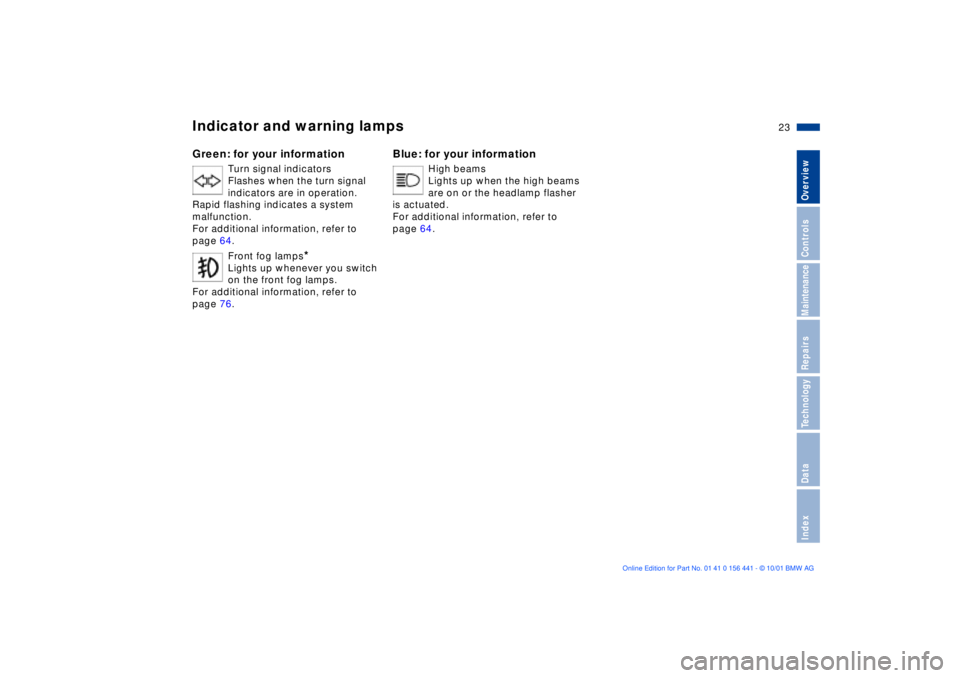
23n
IndexDataTechnologyRepairsMaintenanceControlsOverview
Indicator and warning lampsGreen: for your information
Turn signal indicators
Flashes when the turn signal
indicators are in operation.
Rapid flashing indicates a system
malfunction.
For additional information, refer to
page 64.
Front fog lamps
*
Lights up whenever you switch
on the front fog lamps.
For additional information, refer to
page 76.
Blue: for your information
High beams
Lights up when the high beams
are on or the headlamp flasher
is actuated.
For additional information, refer to
page 64.
Page 24 of 187
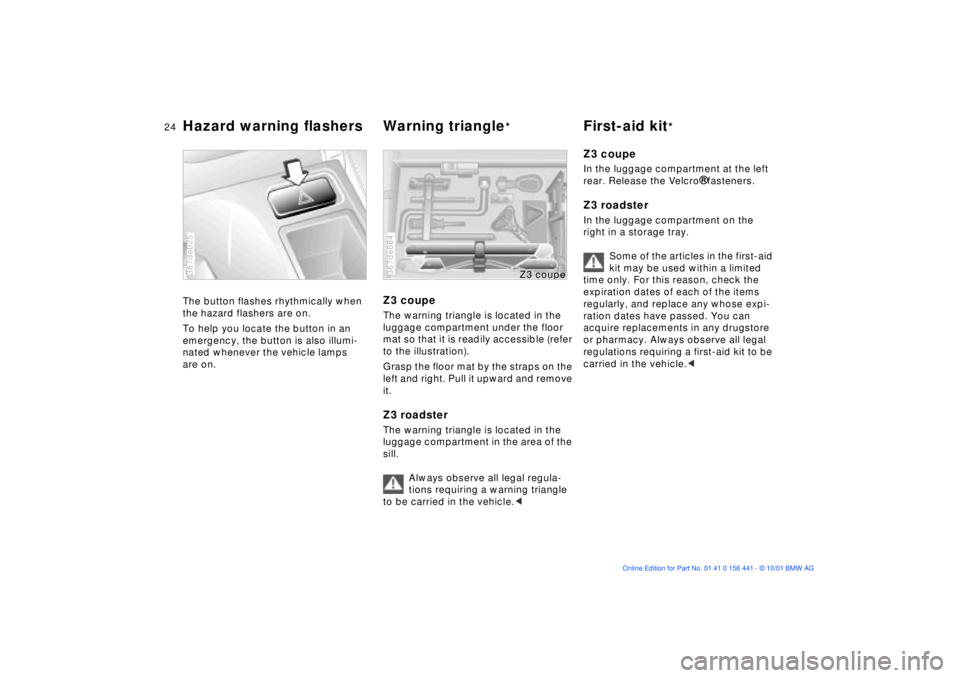
24n
Hazard warning flashers Warning triangle
* First-aid kit
*
The button flashes rhythmically when
the hazard flashers are on.
To help you locate the button in an
emergency, the button is also illumi-
nated whenever the vehicle lamps
are on.367de025
Z3 coupeThe warning triangle is located in the
luggage compartment under the floor
mat so that it is readily accessible (refer
to the illustration).
Grasp the floor mat by the straps on the
left and right. Pull it upward and remove
it.Z3 roadsterThe warning triangle is located in the
luggage compartment in the area of the
sill.
Always observe all legal regula-
tions requiring a warning triangle
to be carried in the vehicle.<367de684
Z3 cou
pe
Z3 coupeIn the luggage compartment at the left
rear. Release the Velcro
¨ fasteners.
Z3 roadsterIn the luggage compartment on the
right in a storage tray.
Some of the articles in the first-aid
kit may be used within a limited
time only. For this reason, check the
expiration dates of each of the items
regularly, and replace any whose expi-
ration dates have passed. You can
acquire replacements in any drugstore
or pharmacy. Always observe all legal
regulations requiring a first-aid kit to be
carried in the vehicle.<
Page 25 of 187
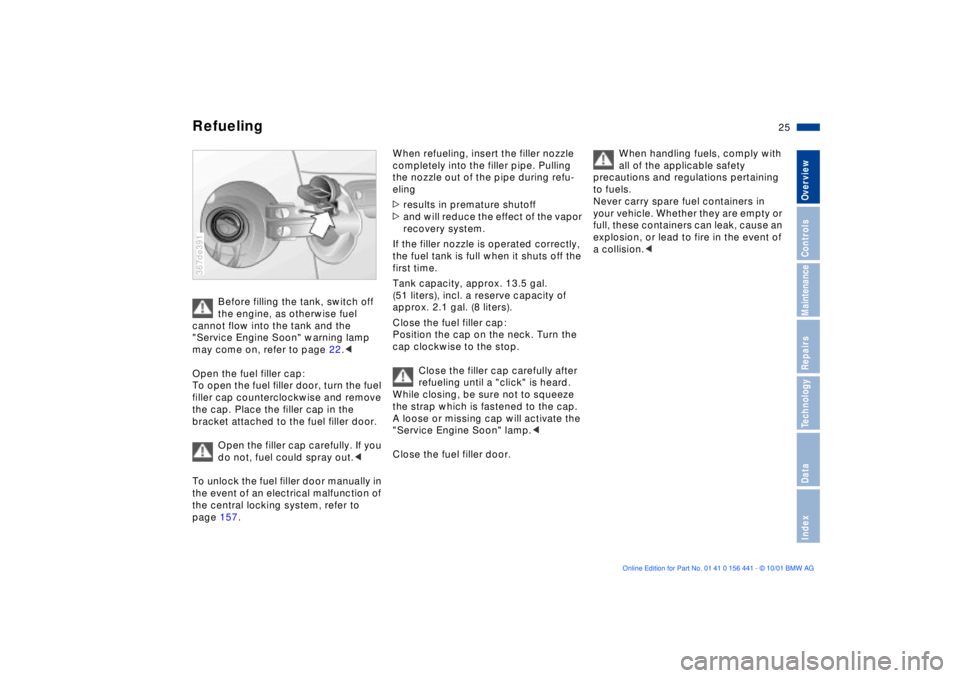
25n
IndexDataTechnologyRepairsMaintenanceControlsOverview
Refueling
Before filling the tank, switch off
the engine, as otherwise fuel
cannot flow into the tank and the
"Service Engine Soon" warning lamp
may come on, refer to page 22.<
Open the fuel filler cap:
To open the fuel filler door, turn the fuel
filler cap counterclockwise and remove
the cap. Place the filler cap in the
bracket attached to the fuel filler door.
Open the filler cap carefully. If you
do not, fuel could spray out.<
To unlock the fuel filler door manually in
the event of an electrical malfunction of
the central locking system, refer to
page 157.
367de391
When refueling, insert the filler nozzle
completely into the filler pipe. Pulling
the nozzle out of the pipe during refu-
eling
>results in premature shutoff
>and will reduce the effect of the vapor
recovery system.
If the filler nozzle is operated correctly,
the fuel tank is full when it shuts off the
first time.
Tank capacity, approx. 13.5 gal.
(51 liters), incl. a reserve capacity of
approx. 2.1 gal. (8 liters).
Close the fuel filler cap:
Position the cap on the neck. Turn the
cap clockwise to the stop.
Close the filler cap carefully after
refueling until a "click" is heard.
While closing, be sure not to squeeze
the strap which is fastened to the cap.
A loose or missing cap will activate the
"Service Engine Soon" lamp.<
Close the fuel filler door.
When handling fuels, comply with
all of the applicable safety
precautions and regulations pertaining
to fuels.
Never carry spare fuel containers in
your vehicle. Whether they are empty or
full, these containers can leak, cause an
explosion, or lead to fire in the event of
a collision.<
Page 26 of 187
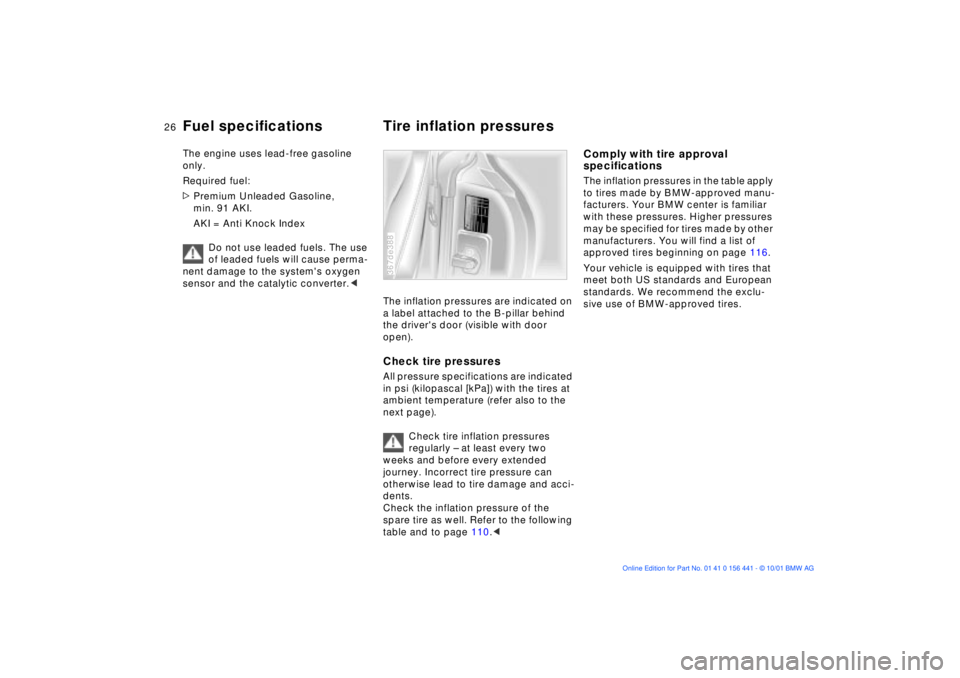
26n
Fuel specifications Tire inflation pressuresThe engine uses lead-free gasoline
only.
Required fuel:
>Premium Unleaded Gasoline,
min. 91 AKI.
AKI = Anti Knock Index
Do not use leaded fuels. The use
of leaded fuels will cause perma-
nent damage to the system's oxygen
sensor and the catalytic converter.<
The inflation pressures are indicated on
a label attached to the B-pillar behind
the driver's door (visible with door
open).Check tire pressuresAll pressure specifications are indicated
in psi (kilopascal [kPa]) with the tires at
ambient temperature (refer also to the
next page).
Check tire inflation pressures
regularly Ð at least every two
weeks and before every extended
journey. Incorrect tire pressure can
otherwise lead to tire damage and acci-
dents.
Check the inflation pressure of the
spare tire as well. Refer to the following
table and to page 110.<367de388
Comply with tire approval
specificationsThe inflation pressures in the table apply
to tires made by BMW-approved manu-
facturers. Your BMW center is familiar
with these pressures. Higher pressures
may be specified for tires made by other
manufacturers. You will find a list of
approved tires beginning on page 116.
Your vehicle is equipped with tires that
meet both US standards and European
standards. We recommend the exclu-
sive use of BMW-approved tires.
Page 27 of 187
![BMW Z3 2002 Owners Manual 27n
IndexDataTechnologyRepairsMaintenanceControlsOverview
Tire inflation pressuresBMW Tires
All tire pressures are in psi
(kilopascals [kPa])
Z3 roadster 2.5i225/50 R 16 92 V
225/50 ZR 1629 (200) 32 BMW Z3 2002 Owners Manual 27n
IndexDataTechnologyRepairsMaintenanceControlsOverview
Tire inflation pressuresBMW Tires
All tire pressures are in psi
(kilopascals [kPa])
Z3 roadster 2.5i225/50 R 16 92 V
225/50 ZR 1629 (200) 32](/img/1/94697/w960_94697-26.png)
27n
IndexDataTechnologyRepairsMaintenanceControlsOverview
Tire inflation pressuresBMW Tires
All tire pressures are in psi
(kilopascals [kPa])
Z3 roadster 2.5i225/50 R 16 92 V
225/50 ZR 1629 (200) 32 (220)
Front: 225/45 ZR 17
Rear: 245/40 ZR 1729 (200)
ÐÐ
32 (220)
205/60 R 15 91 Q M+S
205/55 R 16 91 Q M+S
225/50 R 16 92 Q M+S
225/45 R 17 91 Q M+S32 (220) 35 (240)
Spare tire:
T 115/90 R 16 92 M61 (420) 61 (420)
Z3 roadster 3.0i
Z3 coupe 3.0i225/50 R 16 92 V
225/50 ZR 1629 (200) 32 (220)
Front: 225/45 ZR 17
Rear: 245/40 ZR 1729 (200)
ÐÐ
32 (220)
205/55 R 16 91 Q M+S
225/50 R 16 92 Q M+S
225/45 R 17 91 Q M+S32 (220) 35 (240)
Spare tire:
T 115/90 R 16 92 M61 (420) 61 (420)
Page 28 of 187
28n
Opening and closing:
Keys30
Electronic vehicle
immobilizer31
Central locking system32
Opening and closing from the
outside32
Opening and closing from the
inside36
Luggage compartment lid36
Electric power windows38
Sunroof, coupe39
Convertible top40
Adjustments:
Seats49
Mirrors50
Safety systems:
Safety belts52
Airbags54
Transporting children safely56
Driving:
Ignition lock58
Starting the engine59
Switching off the engine60
Parking brake60
Manual transmission61
Automatic transmission with
Steptronic62
Controls
Page 29 of 187
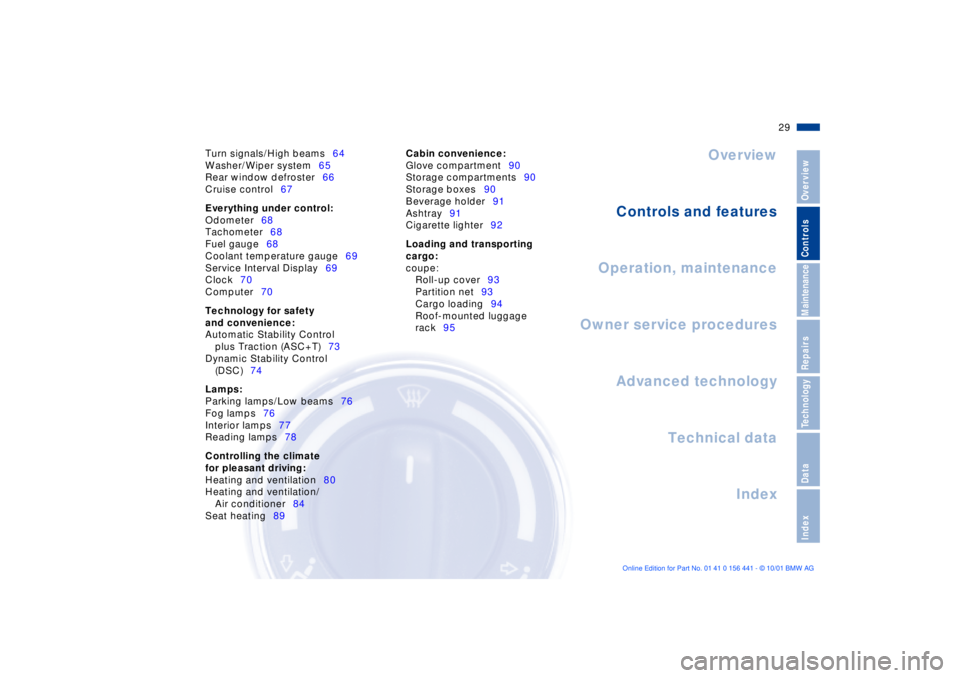
Overview
Controls and features
Operation, maintenance
Owner service procedures
Technical data
Index Advanced technology
29n
IndexDataTechnologyRepairsMaintenanceControlsOverview
Turn signals/High beams64
Washer/Wiper system65
Rear window defroster66
Cruise control67
Everything under control:
Odometer68
Tachometer68
Fuel gauge68
Coolant temperature gauge69
Service Interval Display69
Clock70
Computer70
Technology for safety
and convenience:
Automatic Stability Control
plus Traction (ASC+T)73
Dynamic Stability Control
(DSC)74
Lamps:
Parking lamps/Low beams76
Fog lamps76
Interior lamps77
Reading lamps78
Controlling the climate
for pleasant driving:
Heating and ventilation80
Heating and ventilation/
Air conditioner84
Seat heating89Cabin convenience:
Glove compartment90
Storage compartments90
Storage boxes90
Beverage holder91
Ashtray91
Cigarette lighter92
Loading and transporting
cargo:
coupe:
Roll-up cover93
Partition net93
Cargo loading94
Roof-mounted luggage
rack95
Page 30 of 187
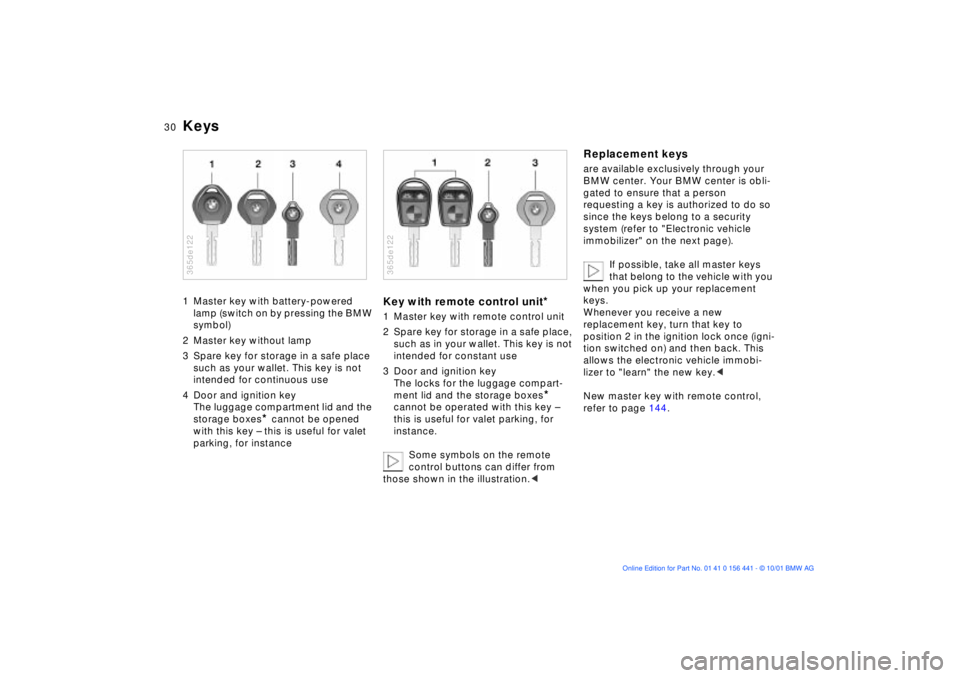
30n
Keys1 Master key with battery-powered
lamp (switch on by pressing the BMW
symbol)
2 Master key without lamp
3 Spare key for storage in a safe place
such as your wallet. This key is not
intended for continuous use
4 Door and ignition key
The luggage compartment lid and the
storage boxes
* cannot be opened
with this key Ð this is useful for valet
parking, for instance
365de122
Key with remote control unit
*
1 Master key with remote control unit
2 Spare key for storage in a safe place,
such as in your wallet. This key is not
intended for constant use
3 Door and ignition key
The locks for the luggage compart-
ment lid and the storage boxes
*
cannot be operated with this key Ð
this is useful for valet parking, for
instance.
Some symbols on the remote
control buttons can differ from
those shown in the illustration.<
365de122
Replacement keysare available exclusively through your
BMW center. Your BMW center is obli-
gated to ensure that a person
requesting a key is authorized to do so
since the keys belong to a security
system (refer to "Electronic vehicle
immobilizer" on the next page).
If possible, take all master keys
that belong to the vehicle with you
when you pick up your replacement
keys.
Whenever you receive a new
replacement key, turn that key to
position 2 in the ignition lock once (igni-
tion switched on) and then back. This
allows the electronic vehicle immobi-
lizer to "learn" the new key.<
New master key with remote control,
refer to page 144.